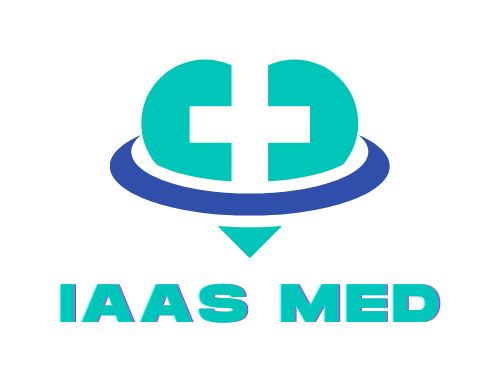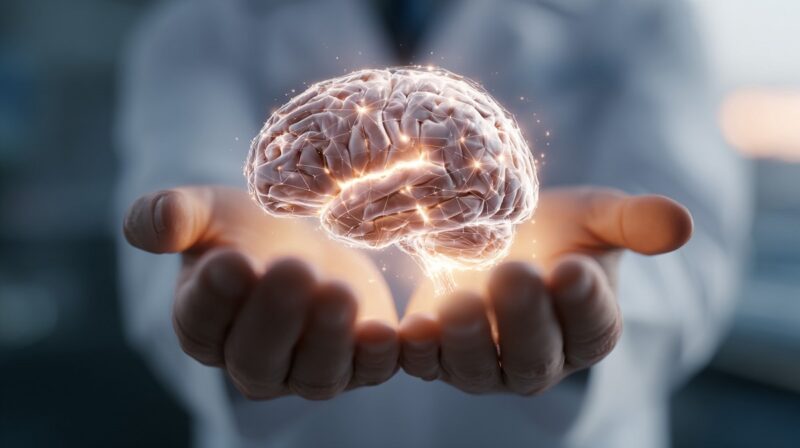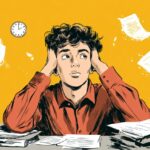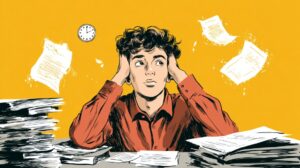Dopamine and norepinephrine are two of the brain’s most influential neurotransmitters. Their delicate balance determines much of what we call “mental health.” Dopamine drives reward, pleasure, motivation, and goal-directed behavior, while norepinephrine governs alertness, energy, focus, and the stress response.
Together, they shape how we feel, think, and act each day. When either system becomes dysregulated, too low or too high, mental health disorders often follow.
Depression, anxiety, ADHD, schizophrenia, and addiction all trace in part to altered levels or receptor sensitivity of these neurotransmitters.
Dopamine: The Reward and Motivation Molecule

Dopamine is often misunderstood as simply the “pleasure chemical.” In reality, it is more about anticipation and reinforcement than pure pleasure. It motivates us to pursue rewarding experiences and keeps us engaged in goal-oriented behavior.
Dopamine is synthesized from the amino acid tyrosine and primarily produced in brain regions like the substantia nigra and ventral tegmental area (VTA). From there, it travels through several neural circuits that define how we perceive reward and motivation.
There are four major dopamine pathways:
- Mesolimbic pathway – governs motivation and reward learning.
- Mesocortical pathway – regulates cognition, decision-making, and mood.
- Nigrostriatal pathway – controls movement and motor function.
- Tuberoinfundibular pathway – influences hormonal regulation through the hypothalamus.
When dopamine levels drop too low, symptoms like fatigue, apathy, or depression appear. Excess dopamine, especially in certain circuits, is linked to psychosis or mania.
The key lies in equilibrium, not in “more dopamine is better.”
| Function | Key Brain Regions | Effect of Low Dopamine | Effect of High Dopamine |
| Motivation and reward | VTA, nucleus accumbens | Apathy, low drive | Impulsivity, addiction |
| Cognition and mood | Prefrontal cortex | Poor focus, depression | Mania, racing thoughts |
| Movement | Basal ganglia | Parkinsonian symptoms | Hyperactivity, tics |
Norepinephrine: The Brain’s Alertness Regulator

Norepinephrine (also called noradrenaline) functions as both a neurotransmitter and a hormone. It is produced mainly in the locus coeruleus, a small nucleus in the brainstem that sends projections across the brain and spinal cord. Its job is to prepare the brain and body for action, heightening alertness, attention, and readiness to respond to challenges.
This system is central to the “fight or flight” response. When danger or stress appears, norepinephrine floods the brain and increases heart rate, blood flow to muscles, and focus.
However, chronic elevation can lead to anxiety, insomnia, and burnout, while deficiency contributes to fatigue, poor concentration, and low motivation.
| Function | Role in the Brain | Low Norepinephrine | High Norepinephrine |
| Attention and focus | Locus coeruleus, cortex | Inattention, ADHD | Hypervigilance, anxiety |
| Energy and arousal | Brainstem, hypothalamus | Fatigue, apathy | Insomnia, stress |
| Emotional tone | Limbic system | Low mood, numbness | Irritability, panic |
How Dopamine and Norepinephrine Interact
Dopamine and norepinephrine are chemically related; both are synthesized from the amino acid tyrosine, and norepinephrine is literally made from dopamine through an enzyme called dopamine β-hydroxylase.
This biochemical link explains why many conditions involving one neurotransmitter affect the other. For instance, a deficit in dopamine often means norepinephrine output is also reduced.
Their interaction defines much of human behavior. Dopamine sparks desire and interest, while norepinephrine sustains attention and effort. A person may feel motivated by a goal (dopamine) but needs alertness and focus (norepinephrine) to complete it.
When dopamine dominates, impulsivity or addiction may occur. When norepinephrine dominates, anxiety and tension can result. A balance between these two is essential for emotional stability and cognitive control.
When this balance is severely disrupted, consulting a psychiatrist becomes essential. A psychiatrist can assess how these neurotransmitter systems function through medical history, symptom evaluation, and sometimes pharmacological trials, guiding treatment choices that restore stability, whether through medication, behavioral therapy, or combined approaches.
Dopamine and Norepinephrine in Mental Health Disorders

1. Depression
Depression involves more than serotonin deficits. Modern neuroscience shows that dopamine and norepinephrine dysfunction play key roles, particularly in “anergic” or “amotivational” depression marked by fatigue, loss of pleasure, and slowed cognition.
Drugs like bupropion target both neurotransmitters to restore motivation and energy. Low dopamine blunts reward sensitivity, while low norepinephrine dampens focus and drive.
2. Anxiety Disorders
Chronic anxiety features overactivation of the norepinephrine system, especially in the locus coeruleus. This produces a constant state of alertness, heart palpitations, and restlessness.
Stress hormones reinforce this cycle, which can eventually lead to burnout and reduced dopamine activity. That’s why anxiety often transitions into depression when the system exhausts itself.
3. ADHD (Attention-Deficit/Hyperactivity Disorder)
ADHD is one of the clearest examples of dopamine and norepinephrine imbalance. Both neurotransmitters are underactive in key brain regions like the prefrontal cortex. This leads to problems with attention, motivation, and impulse control.
Medications such as methylphenidate and amphetamine salts increase the availability of dopamine and norepinephrine in synapses, enhancing focus and self-regulation.
| Disorder | Dopamine Role | Norepinephrine Role | Typical Medication Approach |
| Depression | Low reward sensitivity | Low energy, low drive | Bupropion, SNRIs |
| Anxiety | Often normal or low | High alertness, stress | Beta-blockers, SSRIs |
| ADHD | Underactive in the prefrontal cortex | Deficient arousal control | Stimulants (Adderall, Ritalin) |
| Schizophrenia | Overactive in mesolimbic, underactive in prefrontal | Secondary involvement | Dopamine antagonists |
| Addiction | Overstimulated reward system | Dysregulated stress response | Dopamine modulation, therapy |
Dopamine, Reward, and Addiction
Addictive behaviors, from substance abuse to social media overuse, hijack dopamine circuits. Each “hit” of dopamine reinforces the behavior, creating powerful learning loops. Over time, baseline dopamine levels drop, requiring more stimulation to feel normal.
This process, called downregulation, is a hallmark of addiction and withdrawal. Norepinephrine contributes to the stress and craving side of the cycle, activating the fight-or-flight response during withdrawal or anticipation.
Chronic overstimulation of the dopamine system doesn’t just affect pleasure; it also rewires motivation. Individuals begin to pursue rewards compulsively even when they no longer bring satisfaction.
The Stress Response: A Shared Pathway

When stress hits, norepinephrine surges first, heightening focus and energy. If stress persists, dopamine is gradually depleted, leading to emotional flatness and lack of motivation. This explains why chronic stress is one of the fastest routes to burnout and depressive symptoms.
Balanced dopamine and norepinephrine function allows adaptive stress responses: enough energy to cope, but enough dopamine to feel purpose and satisfaction.
Long-term resilience depends on regulating both systems through adequate sleep, nutrition (tyrosine, omega-3 fatty acids), and rest periods after stimulation. Behavioral therapies, mindfulness, and even structured exercise all help reestablish proper neurotransmitter balance.
The Dopamine-Norepinephrine Connection in Medication
Modern psychiatric treatments often target these two neurotransmitters simultaneously:
- SNRIs (Serotonin-Norepinephrine Reuptake Inhibitors) like venlafaxine and duloxetine elevate both serotonin and norepinephrine, improving energy and focus alongside mood.
- NDRIs (Norepinephrine-Dopamine Reuptake Inhibitors) such as bupropion directly enhance dopamine and norepinephrine signaling, which helps with motivation and cognitive performance.
- Psychostimulants act by increasing synaptic levels of both neurotransmitters, directly improving attention and drive in ADHD and certain forms of depression.
The future of psychiatric medicine is shifting toward precision modulation, customizing which pathways to enhance or suppress based on genetic, metabolic, and behavioral markers rather than one-size-fits-all prescriptions.
Optimizing Dopamine and Norepinephrine Naturally
Neurotransmitter balance is not entirely out of one’s control. Lifestyle and behavioral strategies can significantly affect dopamine and norepinephrine function:
- Exercise: Regular aerobic activity increases dopamine receptor sensitivity and boosts norepinephrine output in the brainstem.
- Nutrition: Diets rich in protein (especially tyrosine-containing foods like eggs, fish, and beans) provide raw materials for neurotransmitter synthesis.
- Sleep: Both systems reset during deep sleep; sleep deprivation lowers dopamine receptor availability and impairs norepinephrine regulation.
- Cold exposure and sunlight: Short-term stressors like cold showers or bright light can stimulate dopamine and norepinephrine release, elevating alertness and mood.
- Mindful reward seeking: Replacing artificial dopamine spikes (social media, sugar, drugs) with slower, intrinsic rewards (skill mastery, social bonding) stabilizes the reward system long term.
Conclusion
Dopamine and norepinephrine form the twin engines of the human mind, driving motivation, focus, pleasure, and resilience. Too little, and life feels dull and exhausting; too much, and thought becomes frantic or chaotic. Mental health, in many respects, is the art of balance between these two chemicals.
Modern neuroscience has shifted from treating neurotransmitters as isolated systems toward understanding their interaction. Whether through medication, therapy, or lifestyle changes, the goal is not to artificially boost one chemical but to restore its coordinated rhythm.
That rhythm, motivation aligned with focus, is what allows the brain to experience purpose, stability, and genuine mental well-being.
Related Posts:
- Top 5 Science-Backed Ways to Improve Your Mental Well-Being
- How Long It Takes to Move Into a Senior Medical Role?
- When to Trust and When to Question Health Advice You…
- Link Between Hormones and Men’s Health Over 40
- How to Restore Gut Health After Antibiotics
- Gallbladder Calculus and Acute Cholecystitis -…















